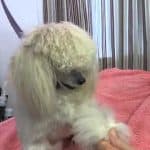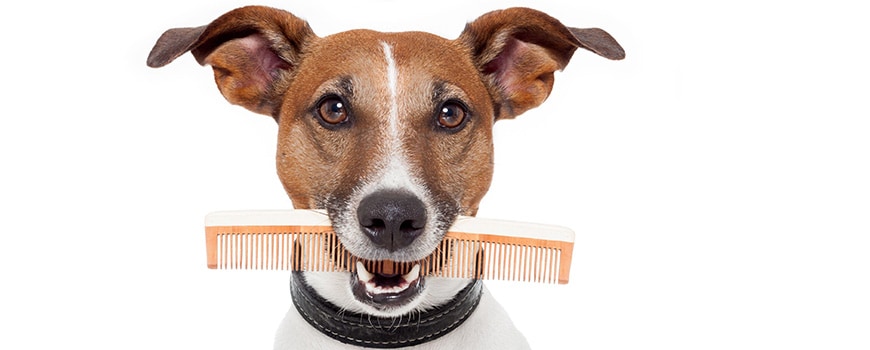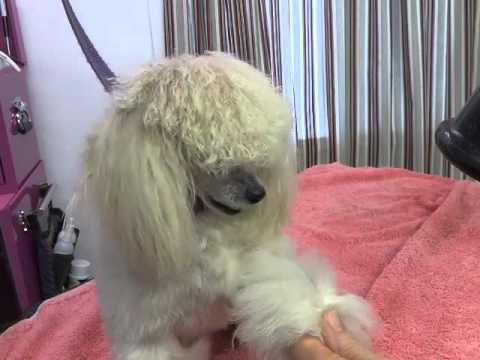Fluff drying is an effect rather than a method. It is, in fact, a stretch-dried coat that has been brushed in reverse! By brushing against the natural direction of growth whilst stretching it, the coat is encouraged to separate and stand up straight rather than lie on the body.
This leaves the coat light and plump, giving the impression of added density and volume. The coat looks quite solid and it is firm and springy to the touch if patted very lightly.
To achieve a good “fluff dry” effect, the entire coat must be continuously brushed in the wrong direction whilst it is being stretch-dried to ensure that the hair dries from the root and all curls are removed from the root outwards.
Reducing the curl reduces the weight and the hairs will no longer hang down because they are straight and buoyant, and instead rise upright and support themselves by standing up against each other. This gives the coat an impression of greater volume.
This technique is generally the preferred and recognized method for drying the wool coats of Poodles, the Bichon Frise and Bedlington Terriers. It can also be used on double coats, the appearance of which benefits from the volume that fluff-drying achieves.
It is a difficult drying skill to master, partly because it requires a lot of effort and partly because you have to work quickly so that you can get the coat straight before it dries. You also have to maintain the reverse brushing action in difficult places, such as the insides of the legs.
Brushing against the natural direction of the coat can be hard work because there is more drag on your brush than there would be if you were brushing the coat the other way. Wool coats also dry very quickly so speed is of the essence.
You can achieve a good “fluff-dry” finish with either a stand dryer or a handheld dryer. A drying cage dries the coat too quickly and it will not have the straight, buoyant, voluminous texture that you require. It requires a fair bit of practice before you get it right, but it is well worth the effort.
You will need:
- a hair-dryer;
- a slicker brush or a pin brush;
- a medium comb to finish with; and
- a spray bottle of water to dampen coat that has dried curly.
Until y ou have mastered the fluff drying technique, you may find that wool coats in particular dry more quickly than you can work; they may therefore dry curly. It is a good idea to keep a spray bottle of water handy to dampen the coat slightly. Be careful not to apply too much water, though, because the dog will be warm and the moisture can quickly turn to steam in the coat.
ou have mastered the fluff drying technique, you may find that wool coats in particular dry more quickly than you can work; they may therefore dry curly. It is a good idea to keep a spray bottle of water handy to dampen the coat slightly. Be careful not to apply too much water, though, because the dog will be warm and the moisture can quickly turn to steam in the coat.
Hold your brush lightly in your hand and use a light flicking action with your wrist as you brush, rather than a hard, forceful action, using your whole arm (imagine that you are whipping cream or beating eggs with a back-hand motion). Watch where you are drying. A dryer with a large outlet nozzle will spread the heat over a large area.
Maintain a brushing rhythm of about one stroke per second and cross the airflow with your brush at every stroke so that you can monitor the heat from the dryer on the back of your hand and straighten the coat at the point of heat contact before it curls.
If the heat reaches areas that you are not watching and monitoring, it may result in the coat drying curly; more seriously, it may cause the skin to overheat or burn.
It is best to start at the bottom of the leg and work upwards. If you start at the top, the fluffed-up hair will fall over the wet hair and get damp again. Steam can get trapped in the underlying damp hair and may scald the skin.
Starting at the bottom and working upwards gives you a better view of the skin so you can monitor it more easily whilst working. It also encourages an upwards brushing motion.
Be methodical in your work. Start by drying a small area, and do not move on to the adjoining area until the coat is completely dry, straight and buoyant. Short hair will dry more quickly than long hair so dry these bits first. Remember to dry the insides of the legs and the bits that you cannot easily see or reach.
The hair still needs to be brushed upwards in these areas. Ear furnishings should also be brushed upwards on both sides of the pinna. The hair underneath the ear, if left curly, will knot very quickly, and the ear furnishings must be continuously brushed straight so ringlets cannot form. Lastly, tails should be brushed towards the dock.
Once dried straight and fluffy, the coat should be back-combed from the bottom upwards, to bring up the pile.
The advantage of fluff drying is that the coat will be light and buoyant in texture, dense in volume and straight in structure, so it is ideal for “sculpting” by trimming and styling as long as you have dried it properly. The disadvantage is that if you do not dry it properly, the coat can become troublesome. Whilst it is the preferred way of drying the wool coat, these coats dry curly very quickly.
It takes practice to perfect the technique of brushing more quickly than the coat is drying to prevent any kinks or waves appearing. Curls and kinks spoil the end result and the coat will have an uneven trim that not only looks unsightly, but may also cause the coat to knot up more easily.
This happens because the shorter hairs curl up again very quickly and wrap themselves around any longer, straightened hairs causing tangles and, very soon, mats.
The sculptured styling on the fluff-dried coat of the Poodle or Bichon Frise can only be successfully achieved if the coat has been dried absolutely straight without curls or kinks in the coat. This includes areas that you cannot always see, such as underneath the dog and on the insides of the legs.
Conclusion
The procedure you use to dry the coat affects the end result of your work, so you need to select the best option for your required finished product.
The most important points to remember when drying the dog are:
- Drying the coat can only be achieved by removing the water either by evaporation (including draught) or centrifuge.
- Evaporation can cause steam to form within the coat layers, causing scalding and overheating.
- Centrifugal forces produced by shaking or with the aid of high-velocity driers and blasters can cause bruising and injury.
- Moving the hair against the direction of the natural growth can cause skin trauma.
- A dryer with a large outlet nozzle spreads heat over a larger area.This can cause skin burns on areas that you are not working on.
To minimize these risks:
- After bathing, the coat should be blotted dry with towels or high-absorbency cloths until it is drip dry.
- Blasters should be aimed across the coat not at the skin, and hair-dryers should be on a low heat and used for as short a time as possible.
- The coat should be moving all the time that artificial heat is being applied so steam cannot build up within the coat and scald the skin.
- Brush the coat where the air from the hair-dryer contacts the hairs (remember the skin is underneath and will be heating up at this contact point). Brushing elsewhere leaves the skin vulnerable to being burnt.
- Monitor all areas that are being affected by the dryer air flow.
- Make sure that the coat is moving if you are using a drying cabinet.
In the majority of instances you will be drying the dog according to the trimming style for the breed but there are always exceptions.
Some dogs have poor quality coats or they may be crossbred dogs that look like one parent but have the coat texture of the other. In these instances the coat needs to be dried according to the coat structure and texture rather than the coat style.
Drying The Coat Against The Direction of Coat Growth
To enable water to run off the topcoat and keep the dog dry, the hair follicles direct or grow the hairs towards the tail and towards the ground. Brushing the coat in the opposite direction can be traumatic to the skin, so you should use as soft brush as possible and brush with as little vigour as possible, watching the skin the whole time you are working.
With the coat being brushed “the wrong way”, the skin is also left vulnerable to the heat from the dryer. Burning of the skin and overheating can easily occur. Try this on your own hair: pull a few hairs in the direction that it grows and then pull the same hairs in the extreme opposite direction – it hurts! This is what is happening when you brush a coat in reverse.

